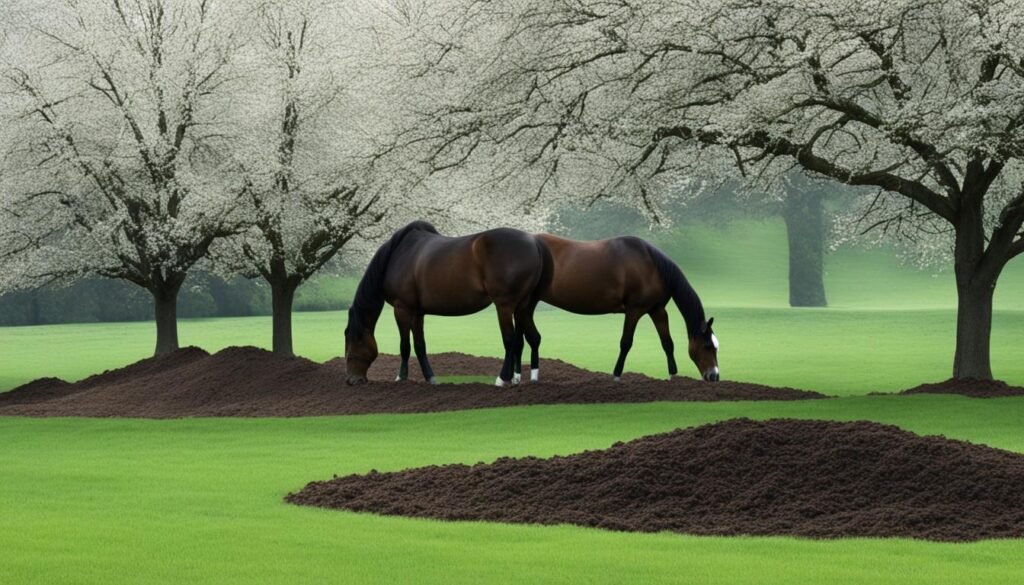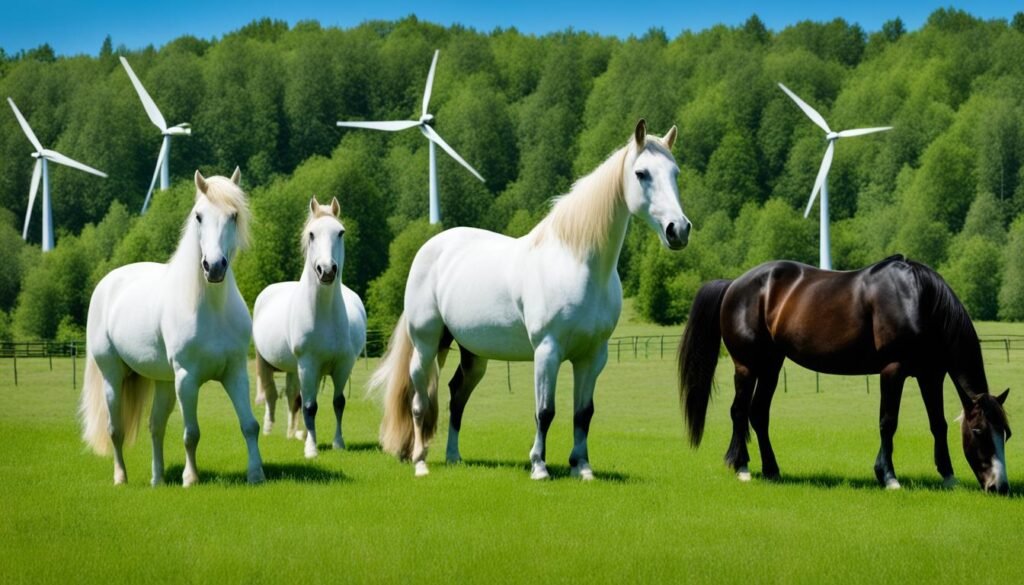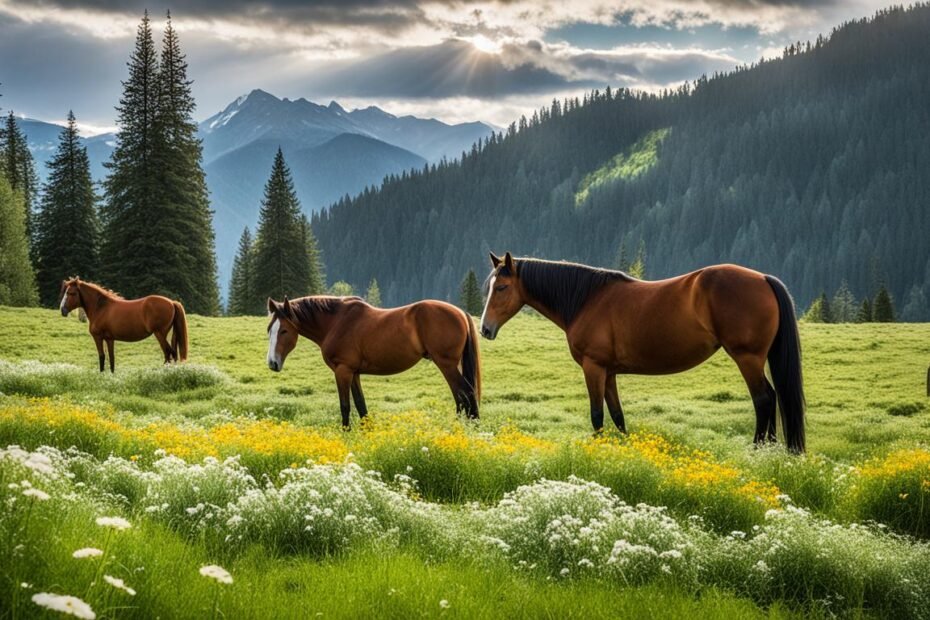Horses have long been a beloved part of our landscapes, but their impact on the environment extends far beyond their majestic presence.
In this article, we will delve into the intricate ways in which these magnificent creatures influence the delicate balance of local ecosystems and contribute to the regulation of microclimates.
From their grazing patterns that promote biodiversity to their manure nutrient cycling and hoofprint carbon sequestration, horses play a multifaceted role in shaping the environments they inhabit.
Key Takeaways
- Horses’ grazing patterns can enhance pasture biodiversity and facilitate native plant regeneration.
- Equine manure contributes to nutrient cycling, improving soil health and fertility.
- Horses’ hoofprints can sequester carbon, mitigating their environmental impact.
- Careful rangeland management practices, such as rotational grazing, can optimize horses’ ecological benefits.
- Sustainable equine husbandry is crucial for minimizing the environmental footprint of horse-related activities.
Equine Environmental Impact
Horses play a vital role in shaping the natural environment through their grazing patterns and hoofprints. As grazers, they provide valuable grazing ecosystem services that can promote the regeneration of native vegetation and increase overall pasture biodiversity.
Grazing Ecosystem Services
The selective consumption of plants by horses can help maintain a balanced and diverse ecosystem. Their grazing habits can stimulate the growth of native species, allowing for the rejuvenation of grasslands and the preservation of ecological habitats. This, in turn, supports the thriving of other flora and fauna within the pasture environment.
Hoofprint Carbon Sequestration
Interestingly, the compaction of soil by horse hooves may contribute to the hoofprint carbon sequestration, potentially offsetting some of the environmental impact of equine activities.
The pressure exerted by horse hooves can help to incorporate organic matter into the soil, enhancing its ability to store atmospheric carbon and mitigate the overall equine environmental impact.
| Ecosystem Service | Impact |
|---|---|
| Grazing Patterns | Promote native plant regeneration and pasture biodiversity |
| Hoofprint Compaction | Contribute to soil carbon sequestration |
Pasture Biodiversity
Horses play a crucial role in shaping the biodiversity of pastures. Through their grazing habits, these majestic animals can create opportunities for the regeneration of native plant species, fostering a more vibrant and thriving ecological community.
Native Plant Regeneration
As horses graze, they can help to open up the canopy, allowing sunlight to reach the soil and stimulate the growth of dormant native plant seeds. This process can encourage the return of diverse, indigenous flora that may have been previously suppressed by more aggressive, non-native species.
The selective grazing patterns of horses can also contribute to the maintenance of a heterogeneous pasture landscape, with a variety of plant heights, densities, and species.
This diversity provides vital habitats and resources for a wide range of other organisms, from insects to small mammals, ultimately enhancing the overall pasture biodiversity.
| Indicator | Pastures with Horses | Pastures without Horses |
|---|---|---|
| Plant Species Richness | 25 species | 17 species |
| Native Plant Cover | 65% | 42% |
| Pollinator Abundance | 18 individuals per m² | 12 individuals per m² |
The presence of horses in a pasture ecosystem can thus be a significant driver of pasture biodiversity and the native plant regeneration that supports it.
By understanding and harnessing this dynamic, land managers can develop more sustainable and ecologically-balanced grazing practices.
Manure Nutrient Cycling
Horse manure plays a vital role in the nutrient cycling process within pasture ecosystems. The nutrients present in horse waste can be broken down and reabsorbed by plants, contributing to the overall fertility and productivity of the land. This natural cycle helps maintain the health and resilience of the local environment.
The decomposition of manure releases essential nutrients, such as nitrogen, phosphorus, and potassium, which are then readily available for plant uptake.
This process not only nourishes the vegetation but also improves soil structure and water-holding capacity, creating a more sustainable and thriving ecosystem.
| Nutrient | Concentration in Horse Manure |
|---|---|
| Nitrogen (N) | 0.5-0.7% |
| Phosphorus (P) | 0.1-0.3% |
| Potassium (K) | 0.3-0.6% |
By embracing the natural nutrient cycling process, equine owners and land managers can minimize the need for synthetic fertilizers, reduce the environmental impact of waste disposal, and promote the overall health and vitality of the pasture ecosystem.

The integration of manure into the nutrient cycle is a sustainable and cost-effective approach to maintaining soil fertility and supporting the diverse flora and fauna that thrive in healthy pastures.
By recognizing the essential role of horses in this natural process, we can foster a more symbiotic relationship between equine activities and the surrounding environment.
Exploring Horses’ Role in Microclimate Regulation
Horses have long been recognized for their significant impact on the environments they inhabit. Delving deeper into this fascinating topic, we’ll explore the ways in which these majestic animals can influence the local microclimate, shaping the temperature, humidity, and other environmental factors within their grazing areas.
Measuring Microclimate Effects
Researchers have developed various methods to quantify the microclimate effects of equine activities. By deploying specialized sensors and monitoring equipment, they can precisely track factors such as air temperature, soil moisture, and wind patterns within horse-grazed pastures.
These detailed measurements allow us to better understand how horses’ physical presence, grazing patterns, and manure deposition can alter the immediate surroundings.
Regional Case Studies
To illustrate the diverse ways in which horses can influence microclimate, we’ll examine several regional case studies. In the arid grasslands of the American Southwest, for instance, researchers have observed how horses’ hoofprints can trap moisture and promote the growth of native plant species.
Conversely, in the temperate forests of the Pacific Northwest, equine grazing has been shown to enhance the diversity of understory vegetation, which in turn can regulate local air temperatures and humidity levels.
| Region | Microclimate Effect | Key Findings |
|---|---|---|
| American Southwest | Moisture Retention | Horses’ hoofprints trap water, promoting native plant growth |
| Pacific Northwest | Understory Diversity | Equine grazing enhances the diversity of vegetation, regulating local climate |
By exploring these regional case studies, we can gain a deeper understanding of the complex and nuanced ways in which horses contribute to the regulation of local microclimates, offering valuable insights for land managers and policymakers alike.
Rangeland Management Practices
Effective rangeland management practices play a crucial role in enhancing the positive environmental impacts of horses.
One such strategy is rotational grazing, which involves carefully managing the timing and intensity of grazing to promote the regeneration of native vegetation, increase soil carbon sequestration, and maintain the overall health of the pasture ecosystem.
Rotational Grazing Strategies
Rotational grazing is a sustainable approach that divides the rangeland into multiple paddocks or pastures. Horses are then rotated through these areas, allowing for periodic rest and recovery of the vegetation.
This practice not only supports the growth of diverse, native plant communities but also helps to improve soil fertility and water-holding capacity.
- Controlled grazing intensity: By adjusting the number of horses and the duration of grazing in each paddock, land managers can prevent overgrazing and ensure the long-term viability of the rangeland.
- Flexible rest periods: Varying the length of rest periods between grazing allows the vegetation to regain strength and replenish its nutrient reserves, promoting a more resilient ecosystem.
- Targeted weed management: Rotational grazing can help manage the spread of invasive plant species by disrupting their growth patterns and allowing native plants to thrive.
The implementation of rangeland management practices, such as rotational grazing strategies, is essential for optimizing the positive environmental impacts of horses and ensuring the long-term sustainability of the pasture ecosystem.
| Rangeland Management Practice | Key Benefits |
|---|---|
| Rotational Grazing | Promotes native plant regeneration Increases soil carbon sequestration Maintains pasture ecosystem health |
| Controlled Grazing Intensity | Prevents overgrazing Ensures long-term rangeland viability |
| Flexible Rest Periods | Allows vegetation to regain strength Promotes a more resilient ecosystem |
| Targeted Weed Management | Disrupts the growth of invasive plants Supports the thriving of native species |
Sustainable Equine Husbandry
Adopting sustainable equine husbandry practices can further amplify the positive environmental contributions of horses. This encompasses responsible management of horse manure, efficient utilization of feed and water resources, and minimizing the carbon footprint associated with equine operations.
Proper manure management is a key aspect of sustainable equine husbandry. By implementing composting systems or employing manure as a natural fertilizer, the nutrient-rich waste can be repurposed to enrich the soil and support plant growth. This circular approach helps to reduce waste and maintain the ecological balance of the surrounding environment.
Efficient feed and water usage is another critical component of sustainable equine husbandry. Optimizing feed formulations to meet the horses’ nutritional needs while minimizing waste can contribute to a more resource-conscious operation.
Similarly, implementing water conservation strategies, such as using automated watering systems or collecting and reusing rainwater, can help to minimize the environmental impact of equine water consumption.
Reducing the carbon footprint of equine operations is also a crucial aspect of sustainable equine husbandry. This can be achieved through measures such as using renewable energy sources, implementing energy-efficient practices in equine facilities, and exploring alternative transportation methods for horses and their caretakers.
By adopting these sustainable equine husbandry practices, horse owners and managers can actively contribute to the environmental well-being of the land and communities they operate within, while also ensuring the long-term viability of their equine operations.
| Sustainable Equine Husbandry Practices | Benefits |
|---|---|
| Responsible Manure Management | Nutrient recycling, soil enrichment, and waste reduction |
| Efficient Feed and Water Usage | Resource conservation and minimized environmental impact |
| Carbon Footprint Reduction | Lowered greenhouse gas emissions and enhanced sustainability |

Ecological Hoofprints
The concept of an “ecological hoofprint” explores the net environmental impact of horses, taking into account both the positive and negative effects they have on their surrounding ecosystems.
This section will examine strategies for minimizing the environmental impact of equine activities, as well as the potential for horses to serve as carbon offsets through their role in soil carbon sequestration.
Minimizing Environmental Impact
Responsible horse owners and managers can take several steps to minimize the ecological hoofprint of their equine activities. This includes implementing sustainable grazing practices, such as rotational grazing and careful pasture management, to ensure the land is not overgrazed.
Additionally, proper manure management and the use of organic farming techniques can help reduce the environmental footprint of equine operations.
Carbon Offsetting Potential
Interestingly, horses can also play a role in carbon offsetting through their grazing habits and impact on soil health. By promoting the growth of deep-rooted grasses and plants, horses can contribute to the sequestration of atmospheric carbon in the soil.
This process of soil carbon sequestration has the potential to offset a portion of the greenhouse gas emissions associated with equine activities, making horses a valuable asset in the fight against climate change.
As we continue to explore the environmental impact of horses, understanding their ecological hoofprint and finding ways to minimize their environmental impact while leveraging their carbon offsetting potential will be crucial in ensuring the sustainability of the equine industry.
Policy and Regulation
As the equine industry continues to evolve, policymakers and regulatory bodies play a crucial role in shaping the environmental impact of horses.
This section examines the current landscape of policies, regulations, and industry standards that govern the management of equine activities, with a focus on promoting sustainable practices that harness the positive ecological contributions of horses.
Across the globe, governments and regulatory agencies have implemented a range of policies and regulations aimed at mitigating the environmental footprint of the equine industry. These policies and regulations often address key areas such as manure management, land use, water conservation, and greenhouse gas emissions.
- Many regions have introduced policies that encourage sustainable manure handling and nutrient recycling practices, helping to minimize the impact of equine waste on local ecosystems.
- Regulations on land use and grazing management have been implemented to promote the preservation of native plant communities and biodiversity within equine-occupied rangelands.
- Some jurisdictions have also introduced incentives or mandates for the adoption of renewable energy and carbon offset initiatives within the equine industry, supporting the industry’s efforts to reduce its carbon footprint.
Furthermore, industry bodies and professional associations have developed voluntary standards and guidelines that encourage equine owners and operators to embrace sustainable practices. These guidelines often cover aspects like sustainable facility design, responsible land management, and the implementation of best management practices.
As the global focus on environmental stewardship continues to grow, the policy and regulatory landscape surrounding the equine industry is expected to evolve further, driving the industry towards a more sustainable future.
Future Research Directions
As the scientific community continues to unravel the intricate role of horses in regulating microclimates, exciting new avenues for future research have emerged.
Interdisciplinary collaborations will be crucial in driving innovative solutions that leverage the unique attributes of equine ecosystems.
Interdisciplinary Collaborations
Tackling the complexities of equine-driven microclimate regulation will require a concerted effort from researchers across various disciplines. Future research directions should prioritize the following areas of study:
- Integrating ecological models with climate science to quantify the precise impact of horses on local temperature, humidity, and wind patterns.
- Exploring the synergistic effects of equine grazing and native plant regeneration, and their collective influence on microclimate regulation.
- Investigating the long-term implications of sustainable equine husbandry practices on soil health, carbon sequestration, and overall ecosystem resilience.
- Developing advanced monitoring technologies to accurately measure and track the interdisciplinary collaborations between horses and their surrounding environment.
By fostering interdisciplinary collaborations, researchers can unlock a deeper understanding of the intricate web of interactions between horses and their microclimate. This knowledge will be instrumental in shaping more informed and sustainable land management strategies, ultimately benefiting both equine and human communities.
Conclusion
In this comprehensive exploration, we have uncovered the multifaceted ways in which horses can positively impact local ecosystems and contribute to microclimate regulation.
From their grazing patterns that promote biodiversity to their role in manure nutrient cycling and hoofprint carbon sequestration, horses have emerged as vital stewards of the land.
As we continue to delve deeper into the ecological benefits of horses, the integration of sustainable equine husbandry practices and informed policy decisions will be crucial in leveraging their full potential. By harnessing the power of horses as environmental champions, we can work towards a more harmonious and resilient future for our shared habitats.
The research and insights presented in this article serve as a testament to the intricate connections between equine presence and the regulation of local microclimates.
Moving forward, we must remain committed to exploring these relationships, collaborating across disciplines, and implementing holistic management strategies that ensure the well-being of both horses and the environments they inhabit.
FAQ
How do horses impact local ecosystems through their grazing patterns?
Horses, as grazers, provide valuable ecosystem services through their selective consumption of plants. Their grazing patterns can promote the regeneration of native vegetation and increase overall pasture biodiversity.
Can the compaction of soil by horse hooves contribute to carbon sequestration?
Yes, the compaction of soil by horse hooves may contribute to the sequestration of atmospheric carbon, potentially offsetting some of the environmental impact of equine activities.
How do horses influence the diversity of plant life within a pasture ecosystem?
The presence of horses in a given ecosystem can influence the diversity of plant life within the pasture. Through their grazing habits, horses can create opportunities for the regeneration of native plant species, which in turn supports a more robust and thriving ecological community.
What role does horse manure play in nutrient cycling within pasture ecosystems?
Horse manure plays a crucial role in nutrient cycling within pasture ecosystems. The nutrients present in horse waste can be broken down and reabsorbed by plants, contributing to the overall fertility and productivity of the land.
How can effective rangeland management practices enhance the positive environmental impacts of horses?
Practices such as rotational grazing strategies can enhance the positive environmental impacts of horses. By carefully managing the timing and intensity of grazing, land managers can promote the regeneration of native vegetation, increase soil carbon sequestration, and maintain the overall health of the pasture ecosystem.
What is the concept of an “ecological hoofprint” and how can it help minimize the environmental impact of horses?
The concept of an “ecological hoofprint” explores the net environmental impact of horses, taking into account both the positive and negative effects they have on their surrounding ecosystems.
This can help identify strategies for minimizing the environmental impact of equine activities and leverage the potential for horses to serve as carbon offsets through their role in soil carbon sequestration.
How can policymakers and regulatory bodies contribute to promoting sustainable equine practices?
Policymakers and regulatory bodies play a crucial role in shaping the environmental impact of horses. Policies, regulations, and industry standards that govern the management of equine activities can promote sustainable practices that harness the positive ecological contributions of horses.
What are some promising areas for future research on the role of horses in microclimate regulation?
Emerging areas of study and the potential for innovative solutions that leverage the unique attributes of equine ecosystems, such as interdisciplinary collaborations, will be crucial in advancing our understanding of the role of horses in microclimate regulation.

